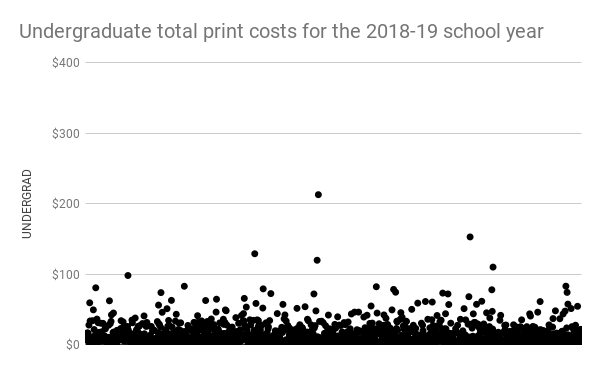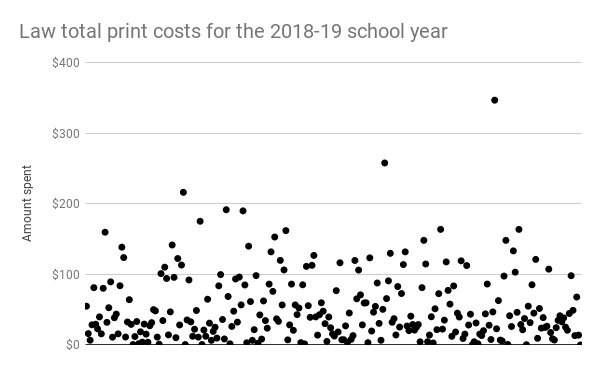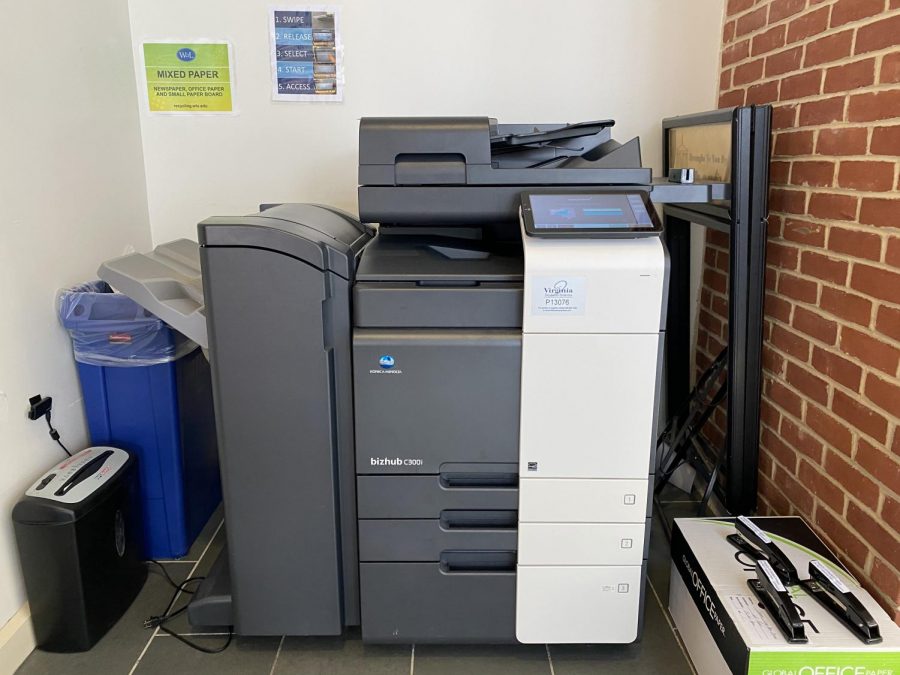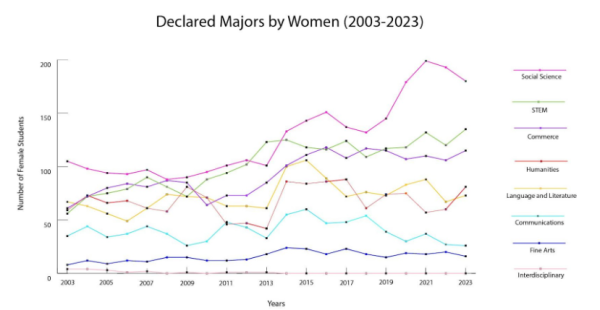Individual students pay more for printing than departments and student organizations, study shows
Students paid nearly $4000 in additional printing costs in the 2018-19 school year
January 28, 2020
Washington and Lee University charges students about 65 percent more for printing than it charges academic departments and student organizations, according to a Ring-tum Phi analysis.
For individual students, colored ink documents cost 30 cents per sheet to print. But that cost is just 17 cents per sheet for departments and student groups.
Single-sided, greyscale sheets costs students 10 cents per sheet to print. For departments and organizations, it’s 6 cents per sheet.
K.C. Schaefer, who oversees copy services as the executive director of auxiliary services, said in an email that the disparity in costs is “somewhat arbitrary” and is a byproduct of an internally transfer of funds.
“A departmental discount was established in order to try and incentivize departments to move to the centrally managed biz-hub and community laser printer machines,” Schaefer said.
The university provides students with a set printing credit for each academic year. If students have printing costs beyond the credit amount, their accounts are billed directly. Law students receive $80 per academic year, and undergraduates receive $50.
“It’s fictitious money,” said Michael Rhodes, manager of copy services. “It’s not really money that comes from anywhere. It’s a subsidy.”
Extra printing costs for departments and student organizations are funded by the university, while students who max out their credit pay for additional printing out of pocket.
“It is annoying that there is a difference in price per page because it’s all coming from and going to the same place,” Madison Baetz, ‘21, said. “Some students print more than others and it varies from semester to semester. It doesn’t quite make sense why Washington and Lee limits anyone’s printing ability.”
The Ring-tum Phi analyzed the printing history for every student account in the 2018-19 school year. Ben Hartless, who manages the university’s PaperCut software, provided the data.


According to the data, the university received almost $4,000 from students paying for extra printing jobs during the 2018-19 school year. Schaefer confirmed the amount.
“There is a significant cost to providing printing services on campus, including equipment and software licensing and rental fees, per use fees, paper and consumable costs, maintenance, etc.,” Schaefer said. “Our goal across printing is to be able to provide this service as close to our actual costs as possible, so very little if any of that $3929 collected would be classified as profit.”
Schaefer said there is no net gain from charging departments and student organizations, since it’s money that the university already collects from tuition and other fees.
“Whether we charged departments $50 per page or $0.02 per page, the net budgetary impact to W&L is the same,” Schaefer said. “We are charging various departments the fees and crediting them to Copy Services, who is charged with maintaining all the [BizHub] machines.”
Schaefer said that if Washington and Lee would elect to raise the undergraduate student credit to $80 to match the law number, then the $30 increase would need to come from a raise in tuition or elsewhere.
Tuition cost $51,420 for the 2018-19 school year and students also paid a $320 technology fee. The fee costs the same for law and undergraduate students and it’s used to cover general technological needs around campus, Rhodes said.
Schaefer said that he does not believe the printing credits come from the technology fee.
One reason for the discrepancy between undergraduate and law students is the difference in printing habits, said Hartless, who also manages the law technology services.
According to the data, the average law student spent $52.29 in printing costs during the 2018-19 school year. With $80 of credits available, more than half of law students had a remaining balance of at least $27.41 in credits.
On average, undergraduates spent $16.22 of their printing credit and had at least $33.78 left in credits, the data shows.
For each individual print job, the average transaction cost about 20 cents higher for law students. Hartless said this is because law students just print more pages per print job than undergraduates.
Despite having more money in printing credits, one out of four law students ran out during the 2018-19 school year, according to the data. Only four percent of undergraduate students spent more than the $50 they were allocated.
Undergraduate McKinley Hamilton, ‘20, said she’s never run out of print credits.
“I mostly read things online and will occasionally print because it is wasteful to print a 50 page reading assignment,”she said. “But, I also think that if it would keep someone from printing and the cost of printing was a barrier, then why should they be hindered academically?”
Studying and printing habits can vary. Some professors require students to print materials for class while others are more willing to print on behalf of students so that they do not have to use their own money, students said.
Despite the push to turn all things digital, research published in the Journal of Research in Reading in 2019 found that reading from screens has a negative effect on reading performance, relative to paper.
Since July 2014, Washington and Lee has used up more than 250 trees from printing paper from campus printers in undergraduate buildings, according to a PaperCut estimate. The energy used could power a single, standard light bulb for over 5.7 million hours, or 570 years.
Charts by Coleman Martinson.













